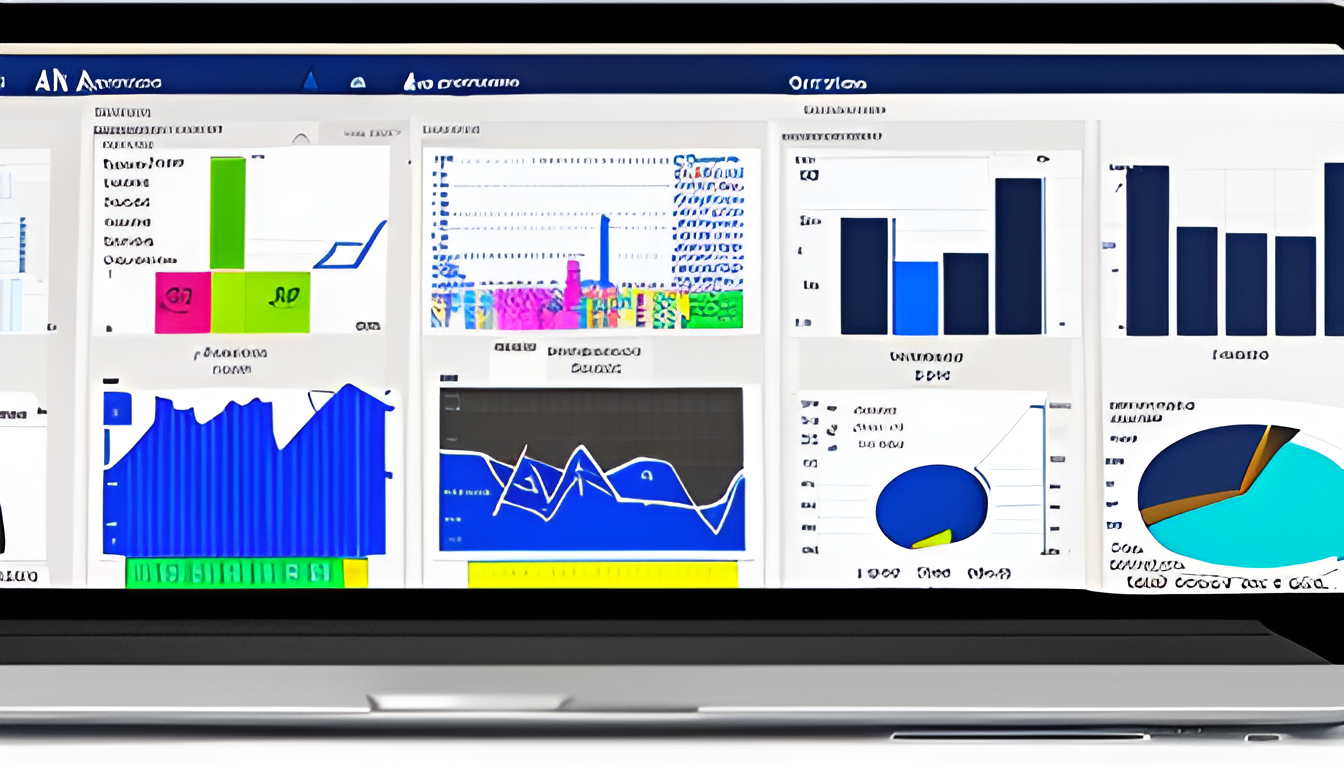How to Grow Your Business with Artificial Intelligence

In today’s fast-paced world, artificial intelligence (AI) is not just a buzzword; it’s a game changer for businesses looking to thrive. Imagine having a tool that can analyze vast amounts of data in seconds, predict customer behavior, and streamline operations—all while freeing up your team to focus on what they do best. Sounds incredible, right? Well, that’s the power of AI!
So, what exactly is AI? At its core, artificial intelligence refers to the simulation of human intelligence in machines that are programmed to think and learn. This technology is revolutionizing the way businesses operate, allowing for improved efficiency and data-driven decision-making. In a landscape where every second counts, leveraging AI can mean the difference between staying ahead of the competition or falling behind.
Before diving into AI implementation, it’s crucial to assess your specific business challenges. What are the areas where you struggle the most? Is it customer service, inventory management, or perhaps marketing? By identifying these needs, you can tailor your AI solutions to address your most pressing issues, ensuring that your investment yields maximum returns.
The market is flooded with AI tools, each boasting unique features and benefits. From chatbots that enhance customer interaction to predictive analytics that forecast trends, the options are endless. The key is to choose tools that align with your business goals. Evaluate your needs, research available solutions, and don’t hesitate to seek expert advice if necessary.
Once you’ve selected the right tools, the next step is integration. This process can seem daunting, but with careful planning, it can be seamless. Ensure that your new AI systems can communicate effectively with your existing processes. This might involve some technical adjustments, but the payoff will be worth it when you see your operations running like a well-oiled machine.
Data is the lifeblood of AI. To harness its full potential, you must prioritize data quality and management. This involves implementing strategies for effective data collection, storage, and analysis. Remember, garbage in means garbage out; if your data is flawed, your AI insights will be too. Invest time in cleaning and organizing your data to ensure accurate results.
AI is only as good as the people behind it. Fostering a culture of AI understanding within your organization is essential. This could mean offering training programs for your existing staff or hiring new talent with AI expertise. The goal is to create a team that is not only comfortable using AI but also excited about its potential to drive growth.
To truly understand the impact of AI on your business, you need to measure success. Establish key performance indicators (KPIs) that align with your growth objectives. Whether it’s increased sales, improved customer satisfaction, or enhanced operational efficiency, tracking these metrics will help you gauge the effectiveness of your AI initiatives.
As you embrace AI, it’s crucial to consider the ethical implications of its use. Issues like fairness, transparency, and accountability should be at the forefront of your AI strategy. Responsible deployment of AI not only protects your brand but also builds trust with your customers.
Real-world examples can provide invaluable insights. Look at companies that have successfully implemented AI solutions. Analyzing their journeys can offer lessons learned and inspire your own AI initiatives.
The landscape of AI is ever-evolving. Staying informed about emerging trends, such as advancements in machine learning and automation, will help you remain competitive. The future is bright for businesses willing to adapt and innovate.
Adopting AI technology can be challenging. Common obstacles include resistance to change, lack of expertise, and insufficient data. However, with a clear strategy and commitment, these challenges can be overcome, paving the way for successful implementation.
In conclusion, the journey to integrating AI into your business may seem overwhelming, but the potential rewards are immense. By understanding AI, identifying your needs, choosing the right tools, and fostering a knowledgeable team, you can harness the power of artificial intelligence to drive growth and innovation. Are you ready to take the leap?
Understanding Artificial Intelligence
Artificial Intelligence (AI) is revolutionizing the way businesses operate. But what exactly is it? At its core, AI refers to the simulation of human intelligence processes by machines, particularly computer systems. This includes learning, reasoning, and self-correction. Imagine having a super-smart assistant who can analyze data faster than any human ever could—this is the power of AI.
The significance of AI in the modern business landscape cannot be overstated. As companies strive for efficiency and innovation, AI emerges as a game-changer. It has the potential to transform operations by automating mundane tasks, providing deep insights through data analysis, and enhancing decision-making processes. For instance, AI can help businesses predict customer behavior, optimize supply chains, and personalize marketing strategies.
Consider this: businesses that leverage AI can gain a competitive edge by not only improving their operational efficiency but also by fostering a culture of innovation. This technology allows for quicker responses to market changes and customer needs, positioning companies at the forefront of their industries. It’s like having a crystal ball that helps you see what’s coming next!
However, understanding AI goes beyond just knowing its definition. It involves recognizing its capabilities and limitations. While AI can process vast amounts of data and identify patterns, it still requires human oversight to ensure ethical and effective use. Therefore, businesses must be prepared to integrate AI thoughtfully, ensuring that it complements human intelligence rather than replacing it.
In summary, understanding AI is about grasping its potential to enhance business operations and drive innovation. As we delve deeper into how to implement AI effectively, it’s crucial to keep in mind that this technology is not just a tool; it’s a partner in your journey towards growth and success.
Identifying Business Needs
In today’s fast-paced market, understanding your business needs is crucial for leveraging the power of artificial intelligence. But how do you pinpoint what those needs are? Think of your business as a puzzle; each piece represents a different challenge or opportunity. By identifying these pieces, you can effectively integrate AI solutions that fit seamlessly into your operations.
Start by conducting a thorough assessment of your current processes. Ask yourself, what areas are causing the most headaches? Is it customer service, inventory management, or perhaps data analysis? Pinpointing these pain points is the first step in determining where AI can make a significant impact. For instance, if your customer service team is overwhelmed with inquiries, an AI-driven chatbot could alleviate some of that pressure, allowing human agents to focus on more complex issues.
Next, consider the opportunities that AI can unlock. This isn’t just about fixing problems; it’s also about enhancing capabilities. For example, if you’re looking to improve your marketing strategies, AI can analyze consumer behavior and predict trends, giving you a competitive edge. By identifying both challenges and opportunities, you create a roadmap for AI implementation that is both targeted and efficient.
It’s also essential to engage your team in this process. They can provide valuable insights into daily operations and highlight areas where AI could be beneficial. Encourage open discussions and brainstorming sessions to gather diverse perspectives. This collaborative approach ensures that the AI solutions you implement are not only effective but also embraced by your team.
Lastly, document your findings and prioritize them based on potential impact and feasibility. Creating a matrix of needs can help visualize where AI can be most beneficial. Here’s a simple example:
| Business Need | Impact Level | Feasibility |
|---|---|---|
| Customer Service Automation | High | Medium |
| Data Analysis | Medium | High |
| Inventory Management | High | Low |
By following these steps, you can effectively identify your business needs and set the stage for successful AI integration. Remember, the goal is not just to adopt technology but to enhance your overall business performance.
Choosing the Right AI Tools
In today’s fast-paced digital world, selecting the right AI tools can feel overwhelming. With countless options available, how do you know which ones will truly propel your business forward? Think of it like choosing the perfect ingredients for a recipe; the right mix can create a masterpiece, while the wrong choices can lead to disaster. The key is to understand your specific needs and match them with the features of the tools available.
Start by evaluating the core challenges your business faces. Are you looking to automate tedious tasks, enhance customer service, or analyze vast amounts of data? Once you pinpoint your goals, you can begin to explore tools that align with those objectives. For instance, if improving customer interactions is your aim, consider AI chatbots that can engage users 24/7, providing instant responses and freeing up human resources for more complex inquiries.
Next, it’s crucial to assess the features of various AI tools. Here are some aspects to consider:
- Scalability: Can the tool grow with your business?
- Integration: How well does it fit with your existing systems?
- User-friendliness: Is the interface intuitive for your team?
- Support and Training: What resources are available to help you get started?
Don’t forget to look into the cost versus benefit of each tool. Sometimes, a higher initial investment can lead to greater long-term savings and efficiency. Conducting a thorough comparison can help you make an informed decision. You might even want to create a simple
| Tool Name | Key Features | Cost | Scalability |
|---|---|---|---|
| AI Chatbot | 24/7 Support, NLP | $50/month | High |
| Data Analysis Tool | Real-time Insights, Visualization | $100/month | Medium |
Ultimately, the right AI tools can transform your business operations, driving efficiency and innovation. Take your time, do your research, and remember that the right choice today can set the stage for your success tomorrow.

Integrating AI into Existing Systems
Integrating artificial intelligence into your existing business systems can feel like trying to fit a square peg into a round hole. However, with the right approach, this transition can be seamless and highly beneficial. First, it’s essential to evaluate your current systems and identify areas where AI can add value. Are you looking to enhance customer service, streamline operations, or improve data analysis? These questions will guide your integration process.
Once you’ve pinpointed the areas for improvement, the next step is to select the appropriate AI solutions. This could range from chatbots for customer service to advanced analytics tools that provide insights into your operations. When choosing these tools, consider factors such as compatibility with your existing software, ease of use, and scalability. Remember, the goal is not just to implement AI for the sake of it, but to enhance your current systems effectively.
To ensure a smooth integration, it’s crucial to follow a structured approach. Here’s a simple framework to consider:
- Assessment: Evaluate your current systems and identify gaps where AI can help.
- Selection: Choose AI tools that align with your business needs and existing infrastructure.
- Testing: Pilot the AI tools in a controlled environment to iron out any issues.
- Training: Provide necessary training for your team to ensure they are comfortable with the new technology.
- Implementation: Roll out the AI solutions across your systems gradually.
Moreover, communication is key during this process. Keep your team informed about the changes and the benefits they will bring. This transparency fosters a culture of acceptance and reduces resistance to new technologies. As you integrate AI, remember to monitor the performance closely. Regular evaluations will help you understand the effectiveness of the integration and make necessary adjustments.
In conclusion, integrating AI into your existing systems is not just about technology; it’s about transforming your business operations. With careful planning and execution, you can harness the power of AI to drive efficiency and innovation, ultimately leading to significant growth.
Data Management for AI
In the world of artificial intelligence, data is the lifeblood that fuels innovation and drives decision-making. Without quality data, even the most sophisticated AI algorithms can falter, leading to misguided strategies and poor outcomes. So, how do you ensure that your data is up to the task? It all starts with understanding the significance of data management in AI applications.
First and foremost, data quality is paramount. This means not only collecting data but ensuring that it’s accurate, relevant, and timely. Think of your data as the fuel for a high-performance engine; if the fuel is contaminated or of low quality, the engine won’t run efficiently. To achieve this, businesses should implement robust data collection methods and regularly audit their data sources.
Next, consider how you will store and analyze this data. A well-structured database can make a world of difference in how quickly and effectively you can access insights. Leveraging cloud storage solutions can provide flexibility and scalability, allowing your business to adapt as it grows. Here’s a quick overview of some popular data storage options:
| Storage Solution | Features | Benefits |
|---|---|---|
| Cloud Storage | Scalable, accessible from anywhere | Cost-effective, easy collaboration |
| On-Premise Storage | Control over data security | Customizable, potentially lower long-term costs |
| Hybrid Storage | Combination of cloud and on-premise | Flexibility, optimized for various needs |
Once you’ve established a solid foundation for data management, it’s crucial to focus on data analysis. This is where the magic happens! Utilizing advanced analytics tools can help you uncover patterns and insights that drive business decisions. Techniques such as machine learning can help automate this process, allowing your team to focus on strategic initiatives rather than getting bogged down in data crunching.
Ultimately, effective data management for AI isn’t just about handling data; it’s about creating a culture that values data-driven decision-making. By prioritizing data quality, storage, and analysis, you’ll set your business up for success in the age of artificial intelligence.
Building an AI-Savvy Team
In today’s fast-paced business environment, having an AI-savvy team is no longer a luxury; it’s a necessity. As more companies turn to artificial intelligence for solutions, the demand for skilled professionals who understand how to leverage these technologies is skyrocketing. But how do you cultivate such a team? It begins with a clear vision and a commitment to continuous learning.
First, assess the current skill set within your organization. Identify gaps in knowledge and expertise related to AI technologies. This can often be achieved through workshops or surveys that gauge familiarity with AI concepts. Once you’ve pinpointed these gaps, you can tailor your training programs accordingly. For instance, you might consider:
- Offering online courses on machine learning and data analysis.
- Organizing hackathons to encourage hands-on experience with AI tools.
- Inviting industry experts for guest lectures or webinars.
Moreover, fostering a culture of collaboration and innovation is crucial. Encourage team members to share insights and experiences related to AI projects. This not only enhances learning but also sparks creativity, leading to innovative solutions. Consider setting up regular brainstorming sessions or innovation labs where employees can experiment with AI technologies without the fear of failure.
Additionally, hiring practices should be aligned with your AI goals. Look for candidates who not only have technical skills but also possess a growth mindset. These individuals are more likely to embrace change and adapt to evolving technologies. A diverse team can also bring different perspectives, which is invaluable when tackling complex AI challenges.
Finally, remember that building an AI-savvy team is an ongoing process. The field of artificial intelligence is rapidly evolving, and staying updated is key. Encourage your team to participate in industry conferences, online forums, and relevant certification programs. By investing in your team’s development, you’re not just enhancing their skills; you’re paving the way for your business to thrive in the age of AI.
Measuring Success with AI
When it comes to artificial intelligence (AI), measuring success is not just about crunching numbers; it’s about understanding the impact these technologies have on your business. Have you ever wondered how to gauge if your AI initiatives are truly making a difference? Well, it all starts with defining clear key performance indicators (KPIs) that align with your business goals. This isn’t just a checkbox exercise; it’s about setting the stage for continuous improvement.
To effectively measure success, consider focusing on the following areas:
- Operational Efficiency: Are your processes running smoother? Look for reductions in time and cost.
- Customer Satisfaction: Is your customer feedback improving? AI can personalize experiences, leading to happier clients.
- Revenue Growth: Are you seeing an increase in sales? Track how AI-driven strategies contribute to your bottom line.
Moreover, it’s essential to establish a baseline before implementing AI solutions. This way, you can compare results pre- and post-implementation. For example, if you’re using AI to enhance customer service, measure the average response time and customer satisfaction scores before and after the AI rollout. This comparison will reveal the tangible benefits AI brings to the table.
Additionally, using a data-driven approach can help you make informed decisions about your AI strategies. Regularly analyze the data collected from your AI systems to identify trends and areas for improvement. This could involve creating a
| KPI | Current Metric | Target Metric |
|---|---|---|
| Operational Efficiency | 30% reduction in processing time | 50% reduction |
| Customer Satisfaction | 75% positive feedback | 90% positive feedback |
| Revenue Growth | 10% increase | 20% increase |
In conclusion, measuring success with AI is a multifaceted approach that requires attention to detail and a commitment to continuous improvement. By setting clear KPIs, establishing baselines, and regularly analyzing performance data, you can ensure that your AI initiatives are not just successful, but also sustainable in the long run.

Ethical Considerations in AI
As businesses increasingly embrace artificial intelligence, it’s crucial to navigate the ethical landscape that accompanies this powerful technology. The integration of AI into business practices can lead to significant advancements, but it also raises important questions about fairness, transparency, and responsibility. Imagine a world where machines make decisions affecting human lives—this is not just a futuristic scenario but a reality we are approaching rapidly.
One of the primary ethical considerations is the potential for bias in AI algorithms. If the data fed into these systems reflects existing prejudices, the outcomes can perpetuate inequalities. For instance, hiring algorithms that favor certain demographics can lead to a lack of diversity in the workplace. Thus, businesses must ensure that their AI systems are trained on diverse datasets to promote fairness.
Moreover, transparency is essential. Stakeholders need to understand how AI systems make decisions. This is where the concept of explainability comes into play. Businesses should strive to create AI models that not only perform well but can also articulate their reasoning. This builds trust among users and mitigates the risk of backlash against perceived “black box” systems.
Another vital aspect is the principle of responsibility. Companies must hold themselves accountable for the outcomes produced by their AI systems. This includes establishing clear guidelines on how AI is used and ensuring that there are human oversight mechanisms in place. For example, if an AI system makes a mistake, there should be a clear process for rectifying the issue and compensating those affected.
In summary, as we harness the potential of AI, we must remain vigilant about the ethical implications of our choices. By prioritizing fairness, transparency, and responsibility, businesses can not only drive innovation but also foster a more equitable future. The journey of integrating AI is not just about technological advancement; it’s about creating a world where technology serves everyone fairly.
Case Studies of AI Success
When it comes to the transformative power of artificial intelligence, real-world examples speak volumes. Companies across various sectors have harnessed AI to not only streamline operations but also to enhance customer experiences. Let’s dive into a few standout case studies that highlight the incredible potential of AI.
One of the most notable examples is Netflix. This streaming giant uses AI algorithms to analyze viewer behavior and preferences, allowing them to recommend shows and movies tailored to individual tastes. By leveraging machine learning, Netflix has significantly increased user engagement and retention rates. Imagine a world where you never have to search for something to watch again—this is the reality Netflix has created through smart AI integration.
Another impressive case is Amazon, which employs AI not just in its recommendation engine but also in logistics and supply chain management. With the help of AI, Amazon can predict product demand, optimize inventory levels, and even automate warehouse operations. This seamless integration of AI has resulted in faster delivery times and a more efficient shopping experience for customers. Who wouldn’t want their packages to arrive at lightning speed?
In the healthcare sector, IBM Watson has made waves by assisting in cancer diagnosis and treatment recommendations. Watson analyzes vast amounts of medical data, including patient records and research papers, to provide doctors with evidence-based treatment options. This not only saves time but also improves patient outcomes. It’s like having a super-intelligent assistant by your side, guiding you through complex medical decisions.
To summarize, these case studies exemplify how businesses can leverage AI to achieve remarkable results. Whether it’s enhancing customer satisfaction, optimizing operations, or improving decision-making processes, the success stories are endless. As more companies adopt AI technologies, the landscape of business will continue to evolve, paving the way for innovation and growth.
Future Trends in AI
As we look ahead into the realm of artificial intelligence, it’s clear that the landscape is evolving at a breakneck pace. The future of AI is not just about machines performing tasks; it’s about creating a synergy between humans and technology that enhances our capabilities. Imagine a world where AI not only assists us but also predicts our needs before we even voice them. This is not science fiction; it’s quickly becoming a reality.
One of the most exciting trends is the rise of machine learning and deep learning. These technologies are becoming more sophisticated, enabling AI systems to learn from vast amounts of data and improve their performance over time. For businesses, this means more accurate predictions, better customer insights, and enhanced decision-making processes.
Moreover, automation is set to redefine how we approach everyday tasks. From automating mundane administrative duties to handling complex data analyses, AI will allow employees to focus on more strategic initiatives. This shift not only boosts productivity but also fosters a more innovative workplace culture.
Another trend to watch is the integration of AI with Internet of Things (IoT) devices. As more devices become interconnected, AI will play a crucial role in analyzing the data generated by these devices, leading to smarter homes, cities, and industries. For instance, smart sensors can optimize energy usage in real-time, significantly reducing costs and environmental impact.
However, with these advancements come challenges. Businesses must address issues of data privacy and security, ensuring that AI systems are not only effective but also ethical. The importance of responsible AI deployment cannot be overstated, as companies navigate the fine line between innovation and compliance.
In conclusion, the future of AI is bright, filled with potential that can transform industries and improve lives. As we embrace these changes, staying informed and adaptable will be key to leveraging AI’s full capabilities. Are you ready to step into the future?
Overcoming Challenges in AI Adoption
Adopting artificial intelligence (AI) can feel like navigating a maze, full of twists and turns that can lead to frustration. However, understanding and addressing the common challenges can turn this maze into a clear path toward success. One of the most significant hurdles businesses face is the lack of understanding about AI capabilities and limitations. Many organizations dive into AI without a clear strategy, resulting in wasted resources and unmet expectations. It’s crucial to start with a solid foundation, educating your team about what AI can realistically achieve.
Another challenge is data quality. AI thrives on data, and if your data is messy or incomplete, the results will be skewed. Investing time in cleaning and organizing your data can make a world of difference. Consider implementing robust data management practices to ensure that your AI systems are fed the best information possible. This includes regular audits and updates to your data sources.
Integration with existing systems can also pose a challenge. Many businesses have legacy systems that may not be compatible with modern AI solutions. To overcome this, it’s essential to assess your current infrastructure and explore ways to either upgrade or find AI tools that can seamlessly integrate with what you already have. A phased approach to integration can help minimize disruption and allow for adjustments along the way.
Moreover, there’s often a fear of job displacement among employees, which can create resistance to AI adoption. To combat this, it’s vital to foster a culture of collaboration between humans and AI. Highlight how AI can enhance productivity rather than replace jobs. Training programs that focus on upskilling employees to work alongside AI can alleviate these fears and make the transition smoother.
Finally, budget constraints can limit AI initiatives. It’s essential to prioritize AI projects that align with your business goals and demonstrate a clear return on investment. Start small, and as you see results, you can gradually expand your AI capabilities. By addressing these challenges head-on, you can unlock the full potential of AI and drive your business forward.

Conclusion and Next Steps
As we’ve explored throughout this article, artificial intelligence is not just a buzzword; it’s a transformative force that can propel your business to new heights. By understanding the nuances of AI and its applications, you’re not just keeping up with the competition—you’re setting the pace. It’s like having a secret weapon in your back pocket, ready to unleash innovation and efficiency at every turn.
To harness the power of AI effectively, it’s crucial to take actionable steps. Start by assessing your business needs and identifying specific challenges that AI can help solve. This targeted approach ensures that your implementation is not just a shot in the dark but a well-thought-out strategy aimed at maximizing impact.
Next, consider the various AI tools available in the market. With options ranging from machine learning platforms to data analytics software, selecting the right tools can feel overwhelming. However, by focusing on your unique requirements, you can choose solutions that align perfectly with your operational goals.
Integration is another key factor. Imagine trying to fit a square peg in a round hole—without proper integration, your AI tools might not deliver the results you expect. Ensure that your new AI systems work seamlessly with existing processes to minimize disruption and maximize productivity.
Moreover, don’t underestimate the significance of data quality. Quality data is the fuel that powers AI. Establish robust data management practices to collect, store, and analyze data effectively, turning raw information into actionable insights.
Finally, foster a culture of AI understanding within your organization. Building an AI-savvy team through training and hiring will empower your workforce to leverage these technologies fully. By embracing AI, your business can not only survive but thrive in this ever-evolving landscape.
In conclusion, the journey to integrating AI into your business is not a sprint but a marathon. Stay informed about emerging trends and continuously evaluate your strategies to ensure you’re on the right path. The future is bright for those willing to embrace the change!
Frequently Asked Questions
- What is artificial intelligence (AI) and how can it benefit my business?
Artificial intelligence (AI) refers to the simulation of human intelligence in machines that are programmed to think and learn. By integrating AI into your business, you can enhance efficiency, automate repetitive tasks, and make data-driven decisions that propel growth.
- How do I identify the specific AI tools my business needs?
Start by assessing your business challenges and goals. Consider what tasks could be automated or improved with AI. Research various tools and their features, and choose those that align best with your identified needs.
- What are the best practices for integrating AI into existing systems?
To ensure a smooth integration of AI, begin with a clear strategy that involves stakeholder input. Train your team on the new tools, gradually implement the AI solutions, and monitor the transition to address any issues promptly.
- Why is data management crucial for AI applications?
Data is the backbone of AI. High-quality data leads to better insights and outcomes. Implement robust data collection, storage, and analysis strategies to ensure your AI applications function effectively.
- How can I build an AI-savvy team?
Foster a culture of learning by providing training and resources related to AI. Encourage your team to stay updated on AI trends and consider hiring individuals with expertise in this field to complement your existing workforce.
- What are the ethical considerations when using AI in business?
It’s essential to prioritize fairness and transparency in AI deployment. Ensure that your AI systems are designed to avoid bias and that their decision-making processes are understandable to stakeholders.
You can explore everything you're looking for in the Wikilogy library. Simply type the keyword and press enter to begin your search.
The word you want to search: History
Sign in to Digital AI News
Create Account
New membership are not allowed.
Notice: ob_end_flush(): Failed to send buffer of zlib output compression (0) in /home/yippuuco/digitalai.news/wp-includes/functions.php on line 5471













